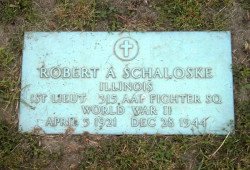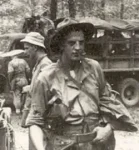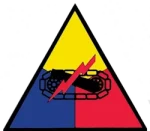1st Lt. Robert August Schaloske was born in Forest Park, Illinois, on April 5, 1921, to Daniel Schaloske and Emilie Lengert-Schaloske and had one sister. The family resided at 236 Lathorp Avenue, Forest Park, and his father died in 1930. He graduated from Saint John Lutheran School and then Proviso Township High School in 1939. After high school, he was employed by Western Tire & Automotive.
Robert registered with Selective Service on February 16, 1942, and named his friend, Jerry Griffith, as his contact person. Knowing he was going to be drafted into the army, he enlisted in the US Army and issued the serial number 16 129 485. He was offered the opportunity to join the Air Corps because of his score on the Army General Classification Test and that his civilian job skills would be best used in the Air Corps. As an aviation cadet, it is known that he trained at Camp Hulen Army Airfield, Texas, Enid Field, Oklahoma, where he completed a nine week course, Aloe Field, Texas, where he completed flight school and was commissioned a second lieutenant on January 7, 1944. His new serial number was O 705 624. He also trained at Sarasota Army Airfield, Florida, and Dale Mabry Airfield, Florida. The last two were training centers for replacement pilots.
Having completed his pilot training he was sent overseas and became a member of 315th Fighter Squadron, 324th Fighter Group, 9th Air Force. Which, at that time, flew P-40F fighters. It appears he joined the unit in Tunisia, North Africa. It is known his unit was moved to Cercola, Italy, October 27, 1943; LeBanca, Italy, June 7, 1944; Matalto di Castro, Italy, June 15, 1944. It was at this time, the squadron’s P-40s were replaced with P-47s which were fighter bombers. The 315th was at Corsica, July 19, 1944; Le Luc , France, August 22, 1944; Istres, France, September 1, 1944; Amberieu, France, September 6, 1944; and Tavaux, France September 17, 1944. At some point, Robert was promoted to first lieutenant.
During its missions against Germany the 315th attacked motor transports, rolling stock, rail lines, troops, bridges, gun emplacements, and supply depots What is known is that on December 16, 1944, the 315th was sent on a mission to Munster, Germany at 10:35 am. Weather conditions were described as being mostly clear with light scatter clouds. During the mission, Robert’s plane, a P-47-27RE, Serial Number 42-26852, was hit by enemy fire near Colmar, Germany, and crashed about five miles southeast of the German town.
2nd Lt. Clarence W. Fisher, a pilot of another plane, stated, “As I pulled up off my dive bombing run, I observed two P-47 aircraft one of the aircraft was smoking slightly as if a burst of power were added. I broke right and glanced back to observe my bomb hits and I lost the two P-47s momentarily and when I again sighted them one P-47 was spinning out of control toward me. I kicked my A/C out of the way and in doing so I observed that the P-47 was burning. The plane hit the ground and exploded, I did not observe a parachute.”
Another pilot, 1st Lt. David L. Giltner stated, “After pulling off my dive bomb run I observed a P-47 aircraft in what looked like someone diving through our string formation. However, and instant after I saw this airplane I saw a parachute fully opened slightly above and east of where I first observed the airplane. We got flak from the target, but I do not know if Lt. Schaloske was hit, the airplane was too far away from me to see any details such as flame or smoke. I did not watch the plane crash. I flew by the parachute about two hundred to the west. I could clearly see the occupant sitting erectly in the seat. The parachute had ceased to oscillate by then and everything was apparently in good order for a normal decent. I observed the location to be two or three miles (possibly more) southeast of Colmar.”
Records show he was reported Missing in Action on December 14, 1944. A telegram was sent to his mother on January 2, 1945.
MRS EMILIE SCHALOSKE
236 NORTH LATHROP AVENUE
FOREST PARK ILLINOIS
THE SECRETARY OF WAR DESIRES ME TO EXPRESS HIS DEEP REGRET THAT YOUR SON FIRST LIEUTENANT ROBERT A SCHALOSKE HAS BEEN REPORTED MISSING IN ACTION SINCE FOURTEEN DECEMBER OVER GERMANY PERIOD IF FURTHER DETAILS OR OTHER INFORMATION ARE RECEIVED YOU WILL BE PROMPTLY NOTIED PERIOD
ULIO
THE ADJUTANT GENERAL
Robert was reported reported Missing in Action on December 16, 1944, but other sources it was on that date that the German’s reported him to be a Prisoner of War. German records show that he had suffered second and third degree burns on his neck, head, legs, and arms after his plane had been hit by enemy fire. He was taken to the German Military Hospital III, Surgical Clinical Hospital, Tuebingen, Germany, where surgery was performed on him. It appears his throat and lungs had also been burned. German records show he died from low blood pressure and weak breathing on December 28, 1944.
After his death, Robert was buried on January 2, 1945, in the civilian cemetery at Tuebingen, Section X, Row I, Grave 11. One of his was sent to the German Information Office in Wehrmacht, Germany. It is not known what happened to the other ID tag. A cross with his name on it was also placed on his grave. Robert’s death was not confirmed until after the war on June 29, 1945, and his mother was sent a letter by the War Department, on July 4, 1945, telling her of his death. She also received a letter from the commanding general of his fighter group.
After the war, in a letter dated February 26, 1946, his mother was information on where Robert had been buried. The date of burial in the letter did not agree with the date given in German documents. On May 6, 1946, the American Graves Registration Service sent a team to the cemetery in Tuebingen, Germany. The team reported that Robert’s remains, and those of other Americans, were recovered in the cemetery. His remains were recorded as X-6206 and taken to United States Military Cemetery, St. Avold, France, and casketed. The AGRS reported that his grave was marked with a cross with his name on it, That the place of his death agreed with all information known about his death, Robert’s German POW records show he was buried in the grave, and cemetery records also show he was buried in the grave and his identification tags were present when the burial took place. His dental records were used to confirm his identification. In the cemetery, he was buried in Plot BBBB, Row 10, Grave 111, on May 26, 1946. In his casket with his remains was buried a bottle containing identification information.
Emilie Schaloske received another letter, dated April 8, 1948, from the Office of the Quartermaster General, Washington, DC, providing her with information on her options for Robert’s final burial. She was asked to complete an enclosed form and return it toe OQMG. (Apparently his mother had moved and contact had to be reestablished.) Another copy of the letter was sent to his mother, and the completed form was received by the office on April 5, 1949. His mother on the form indicated she wanted Robert returned to Illinois for burial.
In May 1949, Robert’s casket was disinterred and by train, on the 5th, the casket was sent to OIC Casketing Point, Antwerp, Belgium, where his remains were placed in a new casket on the 16th. His casket remained there until June 18th when it was placed on the USAT Carroll Victory which sailed the same day. The ship arrived in the New York Port of Entry on June 28th, and his casket remained there until July 28th, when it was sent by train, with a military escort, to Distribution Center #8, Chicago.
On August 2, 1949, Robert’s casket was taken, in a military hears with an escort, to the Zimmerman Funeral Home, Forest Park, Illinois. A wake for Robert was held on the 5th and a funeral Lutheran funeral service for 1st Lt. Robert A. Schaloske, was held on August 6, 1949, He was buried in Forest Home Cemetery, Forest Park, Illinois, in Section 28, Lot 56.







